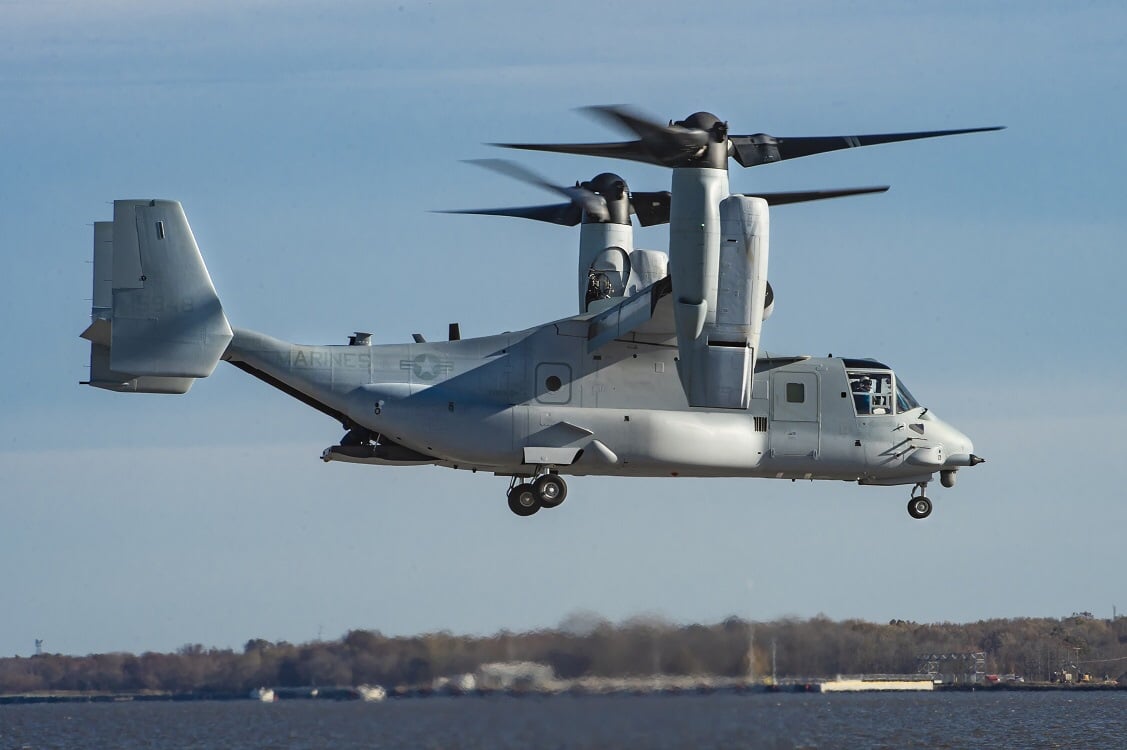Aerospace
Bell Boeing Delivers First Modified Osprey for Improved Fleet Readiness

PHILADELPHIA, Dec. 10, 2019 — Boeing [NYSE: BA] and Bell Textron Inc., a Textron Inc. [NYSE: TXT] company, have delivered the first modified MV-22 Osprey to the United States Marine Corps for improved readiness and reliability of the tiltrotor fleet.
The Marines have multiple configurations of the MV-22 aircraft in service. Under the Common Configuration – Readiness and Modernization (CC-RAM) program, Bell Boeing is reducing the number of configurations by upgrading block “B” aircraft to the current block “C” configuration.
“Our first CC-RAM aircraft returning to Marine Corps Air Station New River was a key program benchmark,” said U.S. Marine Corps Col. Matthew Kelly, program manager, V-22 Joint Program Office (PMA-275). “We are excited to see the capability, commonality and readiness improvements these CC-RAM aircraft bring to the fleet as part of the Marine Corps’ V-22 readiness program.”
As a block “B” configuration, this MV-22 was originally delivered to the fleet in 2005. In 2018, the aircraft flew from Marine Corps Air Station New River to the Boeing Philadelphia facility for modernization.
“This milestone marks the beginning of an Osprey evolution,” said Kristin Houston, vice president, Boeing Tiltrotor Programs and director, Bell Boeing V-22 Program. “Through a shared focus on safety and quality, the Bell Boeing team is delivering modernized MV-22 aircraft that are ready to serve our dedicated servicemen and women who rely on this essential aviation resource.”
The next CC-RAM delivery is expected in early 2020.
“We look forward to having the remaining MV-22 block “B” aircraft rejoin the fleet in a block “C” configuration,” said Kelly.
In November 2019, the U.S. Navy awarded Bell Boeing $146,039,547 to upgrade nine additional MV-22 aircraft under the CC-RAM program, with work expected to be completed in March 2022.

Aerospace
When Ratan Tata was denied entry to the airfield at the Aero India show, he waited

During our visit to Aero India 2019, we had the unexpected opportunity to see Ratan Tata at the event, which was a thrilling moment for us. However, there was a surprising hiccup when the security staff didn’t allow him to enter due to a lack of a security pass.
Despite this, he remained calm and patiently waited for about 20 minutes until a member of the Tata team brought him the required pass, after which he calmly proceeded inside. It was a humbling sight, showcasing his composed demeanor even in such situations.
Ratan Tata ji is not only a renowned industrialist but also a trained pilot, holding a pilot’s license. In 2007, he became the first Indian civilian to fly the F-16 Falcon during the Aero India show in Bangalore—a proud moment for the nation.
His passion for aviation extended beyond flying, as he played a key role in shaping India’s aerospace industry. Under his leadership, Tata ventured into manufacturing and maintaining aerospace components while upholding its legacy of quality. Notably, Tata’s collaboration with Airbus to develop and manufacture the C295 aircraft is a testament to its growing influence in the sector.
-

 Aviation2 months ago
Aviation2 months agoMicrosoft Flight Simulator Raises $3 Million to Bring Back the An-225 Mriya
-

 Airlines2 months ago
Airlines2 months agoQatar Citizens Can Travel to the United States Without a Visa
-

 Aviation2 months ago
Aviation2 months agoQatar Airways bans these new Electronic Devices on plane
-

 Airlines2 months ago
Airlines2 months agoJapan Airlines Rolls Out Free Domestic Flights to International Passengers
-

 Defence2 months ago
Defence2 months agoWhich Country Has the Largest Fleet of Fighter Aircraft?
-

 Airport2 months ago
Airport2 months agoWestern Sydney Airport Welcomes Its First Plane After 6 Years of construction
-

 Airlines4 days ago
Airlines4 days agoDAMAC Air: Dubai’s New Luxury Airline Offers Free Flights for Registration
-

 Aviation2 months ago
Aviation2 months agoDid you know ? Once Boeing 747 carried 1088 passenger in 1991








